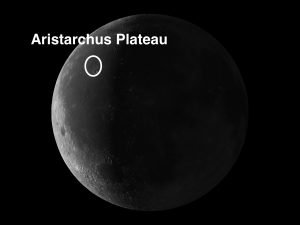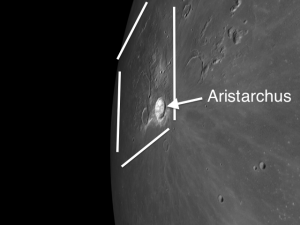 The week of Jan. 23-29 takes us from Lunar Day 25 through Day 1. For you early viewers, the Moon doesn’t rise until around 3:15 A.M. (depending on your location) and it won’t be high enough to view clearly until 5:15 or so, with nautical dawn ending at around 6:00 A.M. This week we will highlight the Aristarchus Plateau. (Because there will be a limited number of observers up at this hour, this information will be repeated on a future blog covering Lunar Day 11.)
The week of Jan. 23-29 takes us from Lunar Day 25 through Day 1. For you early viewers, the Moon doesn’t rise until around 3:15 A.M. (depending on your location) and it won’t be high enough to view clearly until 5:15 or so, with nautical dawn ending at around 6:00 A.M. This week we will highlight the Aristarchus Plateau. (Because there will be a limited number of observers up at this hour, this information will be repeated on a future blog covering Lunar Day 11.)
 Aristarchus Plateau: [NW/G4-5; L=50°W] This plateau is a diamond-shaped feature with straight sides measuring 100 x 125 miles and is over a mile higher than the surrounding mare areas. It is conjectured that the plateau was uplifted because of the pressures exerted by underground magma. It is an unusual object not only because of its straight sides but because it is covered by a mantle of pink-colored pyroclastic ash 30 to 100 feet thick. The Plateau has attracted the attention of NASA as an area for lunar colonization because hydrogen and oxygen can be extracted from the ash, providing fuel, water, and breathable air.
Aristarchus Plateau: [NW/G4-5; L=50°W] This plateau is a diamond-shaped feature with straight sides measuring 100 x 125 miles and is over a mile higher than the surrounding mare areas. It is conjectured that the plateau was uplifted because of the pressures exerted by underground magma. It is an unusual object not only because of its straight sides but because it is covered by a mantle of pink-colored pyroclastic ash 30 to 100 feet thick. The Plateau has attracted the attention of NASA as an area for lunar colonization because hydrogen and oxygen can be extracted from the ash, providing fuel, water, and breathable air.
The reddish color of the plateau is distinctive and sets it apart from the gray of the surrounding terrain. (Other observers see greenish or yellowish tones. What do you see?)
OF ADDITIONAL INTEREST ABOUT THE MOON:
New research based on uranium-lead dating of fragments of zircon no larger than a grain of sand brought back by Apollo 14 astronauts indicates the Moon was created only within 60 million years after the formation of the solar system (4.51 BYA). And Israeli scientists at the same time came up with a new theory that the Moon was not created when a Mars-sized object slammed into it (an event informally known as “the Big Whack”), but perhaps by a series of smaller collisions which may have created multiple moonlets that then coalesced into one large moon.
======================
It is highly recommended that you get a copy of Sky and Telescope’s Field Map of the Moon, the very finest Moon map available for use at the telescope. It is available for $10.95 at www.skyandtelescope.com and on Amazon. All features mentioned in this blog will be keyed to the grid on the Field Map and will look like this: Plato: [NW/D9]
Credits:
Courtesy of Gray Photography of Corpus Christi, Texas
Lunar photos: NASA / USGS / BMDO / LROC / ASU / DLR / LOLA / Moon Globe. Used by permission
- Rupes Cauchy: A Best Known Fault on the Moon - July 22, 2024
- Moon Crater Schickard – Crater Floor has Stripes - July 15, 2024
- Moon Craters Langrenus and Vandelinus - July 8, 2024
